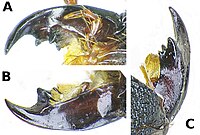Platydracus stercorarius
| Platydracus stercorarius | ||||||||||||
|---|---|---|---|---|---|---|---|---|---|---|---|---|

Platydracus stercorarius |
||||||||||||
| Systematics | ||||||||||||
|
||||||||||||
| Scientific name | ||||||||||||
| Platydracus stercorarius | ||||||||||||
| ( Olivier , 1795) |
Platydracus stercorarius is a beetle from the family of Rove . The genus Platydracus is represented in Europe with only one subgenus and eight species . The species P. stercorarius occursnot only in the nominate form but also in the subspecies P. s. fuscofemoratus .
The genus name Platydracus is from Altgr. πλατύς platýs "broad, flat" and δράκον drákon "dragon" derived and roughly means "flat predator". The species name stercorārius is derived from the Latin "stércus, stércoris" for "dung" and means "living in dung". It refers to the fact that the beetle is often found in manure. The subspecies P. s. fuscofemoratus has blackened thighs (from Latin "fúscus, a, um" for "brown" and "fēmur, fēmoris" for "thigh") in contrast to the trunk form.
A synonym for Platydracus stercorarius is Platydracus crebrepunctatus . The name is from Lat. "crēber, a, um" for "dense" and "punctātus, a, um" for "dotted" are derived and alludes to the dense dotting of the head and pronotum.
features
The beetle reaches a length of twelve to fifteen millimeters, "up to two centimeters" are also given. The head and pronotum are blue-black with little metallic sheen. Both are densely dotted with fine navel (Fig. 6) and finely and inconspicuously dark haired. The wing covers , antennae and legs are light brown-red, the latter in the subspecies P. s. fuscofemoratus dark.
The head narrows in a trapezoidal shape towards the front, the mouthparts point towards the front. Behind the sideways, flat eyes , the temples are long and slightly widened towards the back. The feelers arise in front of the eyes above the deflections of the upper jaw . Their turns are further apart than they are from the front edge of the eyes. The antennae are cord-shaped, eleven-limbed and hardly broaden outwards. The upper jaws are noticeably toothed (Fig. 2). In all species of the genus, the teeth are not only located in one plane on both upper jaws, but also above and below the plane defined by the upper jaw. Behind the eyes there is a point of bristles that is significantly farther away from the rear edge of the eye than from the rear edge of the head (Fig. 4). The four-part jaw probe and the three-part lip probe end with a spindle-shaped, truncated member that is bristle-free (Fig. 3).
The pronotum is rounded at the back and pulled down sharply on the sides. The underlaid parts are not visible even from the side.
The red to red-brown elytra are trimmed behind and leave most of the abdomen uncovered.
The black abdomen is conspicuously patterned by white-gray hair. On the first to fourth abdominal segments there is a white-gray, triangular spot in each of the anterior side corners of the rectangular back shields ( tergites ), on the following two tergites a wide horizontal stripe connects the two edge spots. In the front segments, there is usually a smaller, inconspicuous, middle spot between the conspicuous marginal spots.
The rear hip cavities are bordered at the back. The process of the middle breast between the middle hips is only narrow. The tarsi are all five-part.
biology
The beetle can be found in open areas, for example on the forest floor. He lives predatory. Its prey consists largely of fly larvae, which is why the beetle can often be found on dung.
You meet the animals between May and September, the maximum occurrence is in August. They prefer dry, sandy soils. They are often found in or near nests of the ant Tetramorium caespitum .
distribution
The species is common in central and northern Europe including the British Isles . The distribution area continues east to the Caucasus .
literature
- Heinz Joy, Karl Wilhelm Harde, Gustav Adolf Lohse: The beetles of Central Europe . Volume 4 Staphylinidae I. Goecke & Evers Verlag, Krefeld, 1964
- Edm. Reitter: Fauna Germanica, the beetles of the German Empire, Volume II, KG Lutz 'Verlag, Stuttgart 1909
Individual evidence
- ↑ a b c d Platydracus stercorarius in Fauna Europaea. Retrieved December 10, 2011
- ↑ Platydracus (subgenus) in Fauna Europaea. Retrieved December 10, 2011
- ↑ a b Sigmund Schenkling: Explanation of the scientific beetle names.
- ↑ a b c d Aleš Smetana and Anthony Davies: Reclassification of the North Temperate Taxa Associated with Staphylinus Sensu Lato, Including Comments on Relevant Subtribes of Staphylinini (Coleoptera: Staphylinidae). American Museum Novitates, Number 3287: 1-88. 2000. as PDF at Bioone
- ↑ Polish coleopterological page on Art
- ↑ F. Dahl: The animal world of Germany and the adjacent parts of the sea: 37th part. Hymenoptera or Hymenoptera. H.Stitz. Verlag Gustav Fischer Jena, 1939 as PDF ( page no longer available , search in web archives ) Info: The link was automatically marked as defective. Please check the link according to the instructions and then remove this notice.



